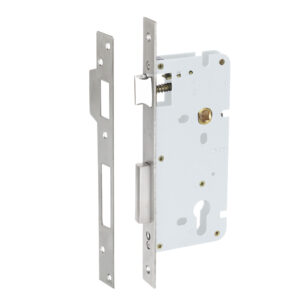- An ISO 9001:2015 Company
- +91 - 99671 33244
- [email protected]
Know The Different Types of Euro Profile Cylinder Lock & Its Features
March 18, 2021What Doors Does a Smart Lock Euro Cylinder Fit On?
August 27, 2021Mortise locks are a form of lock collection that is used in the mechanical security industry. They are used in applications that require a lock that is both heavy-duty and high frequency. The modern mortise lock differs significantly from the typical cylindrical lock, which has the cylinder installed in the lever and the latch bolt connecting to the chassis. The mortise lock also differs from a cell lock, also known as a pre-assembled lock, which merely falls out of the box and is placed into a pre-cut area in the door for that lock.

Installing a mortise lock necessitates precise weighing and cutting with mortise lock manufacturers who have experience with basic nuts and bolts. Cutting errors, such as making a cavity that is too deep, large, or wide, will result in the lock performing poorly or not being able to be installed at all. Of course, cutting errors are difficult to correct, and even the most skilled repair job can damage the door’s structure. Mortise lock suppliers usually recommend that mortise locks be fitted appropriately. When appropriately installed, the protection will be more stable and will last longer.
Why Mortise Locks Are So Mysterious: Here Are the Five Reasons
Have Odd-Shaped Mechanical Parts
Mortise locks are made up of several oddly designed mechanical components sealed within a heavy-gauge steel case punctured with circular and square holes that appear to represent a hidden code.
Mysteriously Hidden Bodies
The bodies of mortise locks are mysteriously concealed inside a pocket cut into the door’s lip. The mortise lock installation is usually not a do-it-yourself job. Mortise lock manufacturers use a mortising jig to make accurate pocket cutting an easy process. However, if the contractor is a novice, the exterior trim’s resulting implementation may be perplexing.
Function In Multiple, Enigmatic Ways
Mortise locks may work in a variety of mysterious ways. School and hospital entrance, laboratory, classroom safe, office, passage, and storeroom functions are the most general. However, there are a variety of other operations for locking and unlocking doors. Although the latches and the bolt can have some hints, you can’t generally tell how the mortise lock works only from looking at the mortise lock trim.
Mortise lock cutouts may weaken the structure of the door
Yet, for whatever reason, mortise locks are better than bored cylindrical locks! They have more leverage and last longer than cylindrical locks, and their versatility allows for greater architectural compliance with current security hardware.
Mortise locks, which are commonly used on older homes, are usually worked using a skeleton key.
Different Internal Working Parts
Internal working sections of mortise locks vary significantly from those of regular bored cylindrical locks. A typical cylindrical door lock is more common on residential doors and can be identified by the lock cylinder mounted inside the handle or knob.
To function correctly, a mortise door lock requires a mortise, or pocket, to be inserted in the door frame. The mortise lock’s bolt is inserted into the mortise. When you install the locks, they must fit into a pocket or mortise in the frame. That is why it is referred to as a mortise lock. So, to insert the box lock, you must first cut a mortise in the frame. The critical thing to remember here is that not all doors can accommodate a mortise lock’s installation. Therefore you should get clear information from mortise lock parts suppliers.
Overall, a mortise lock is a high-performance security lock intended to fit into the mortise or pocket of individual doors. As a result, before inserting the mortise lock, ensure that the door is thick and solid. I would recommend using a mortise lock on a door that is about 2 inches wide. Alternatively, choose a door that would be impossible for any intruders to smash in.
